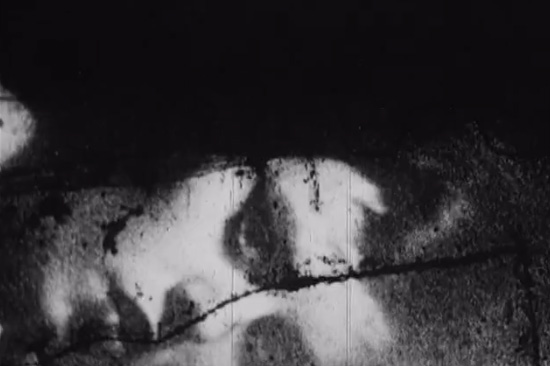Luciana Botelho turns cab rides in Tokyo into a gorgeous abstraction that maintains its romantic atmosphere flawlessly. What I like about these films is how the filmmaker seems able to surrender herself to a particular time and place over the extended period of time necessary for making the film. Not an easy thing to do. I’ve posted about this filmmaker’s work before.
Tag Archives: avant-garde
Nightlife in a Puddle – A Film by Fabio Scacchioli
Fabio Scacchioli is an Italian filmmaker who turns ordinary shots on Super 8 film and video into magical and mystical pieces about memory and all that it does for us. I am always impressed by his work and how he finds the perfect moments to let glimmer through the haze to catch us unaware. I maintain that as we move further into the 21st century, we are developing a new cinema completely removed from the theatrical aspects of the last century’s cinema. It is filmmakers who do not try to make films that look like American features who will make the new cinema. Filmmakers making films that look like American features are looking at forms as outmoded as 19th century theatrical works were during the age of the early silents. The new cinema is as natural and immediate a form of expression as writing or painting.
I know that Scacchioli is currently working on something new and I’m looking forward to seeing it. I’ve posted about Scacchioli’s work before.
Dreams That Money Can Buy – 1947 Underground Feature Film by Hans Richter
Inspired by a Hans Richter film posted by Dangerous Minds, I went looking for more. I found this extraordinary gem, Dreams that Money Can Buy, which is a low-budget feature film produced and directed by Richter with some of his incredible friends in 1947. They shot the film in a New York loft. It’s essentially an underground experimental film about a guy who gets an apartment and worries about how to pay the rent. When he discovers that he has the power to see into his mind through the reflection of his eye, he seizes upon an idea to create a business selling dreams to people who are unhappy with their lives. So of course the film features seven surrealist dream sequences!
Brilliant! Some of the people involved with this fantastic film were Max Ernst, Paul Bowles, Marcel Duchamp, Alexander Calder, John Cage, Fernand Leger, and Man Ray.
You can watch the film in its 8 YouTube parts right here or you can go download it from Archive.org.
Part 2
Parts 3 – 8 after the jump!
Ghosts Before Breakfast – Surrealist Short by Hans Richter
Richard Metzger at Dangerous Minds posted about this 1927 film by Hans Richter. Considered one of the first examples of surrealist film, it’s a daydream that uses stop-motion animation to make people and objects do totally irrational and impossible things. Richter was a part of the Dada movement in art which rebelled against ordinary life and assumptions, attempting to expose the meaninglessness behind modern life. Out of Dada came the Surrealist movement. The music for this version is from a new score by Nikolai von Sallwitz.
Thank you Mr. Metzger and Dangerous Minds!
The Films of Luciana Botelho
I once suggested on this web site picking up a camera and spending the day on a street corner making a film. Moulin Rouge is a film that does that with spectacular and sublime results. Filmmaker Luciana Botelho wanders the world with her camera and makes films that take my breath away. Standing in front of the Paris landmark, she makes a film that celebrates movement more effectively than anything going on inside the actual Moulin Rouge. Her film is also a very simple and charming celebration of the act of photographing or filmmaking. Botelho’s films are beautiful and subtle and extremely emotional. She fits image to music perfectly. I’m ready to go and buy all the songs after watching these!
With the great pile of film and video available on the web, one must maintain some sensitivity to the gentle – the delicate. Botelho is a gentle filmmaker. She impresses me because she seems to me to be an artist of the glance. Her art seems based on immediate vision and impressions made almost in passing. She makes films about travel that capture the essence of a place, but primarily focus on the behavior of people, turning the overlooked into something captivating. The films hold an enormous grace and convey very powerfully the impression of an artist whose every turn of the head can lead to a film.
I like the fluctuating frame rate of these films. It focuses you in on the interesting physical movements caught by the camera in everyday situations. And yet the films flow smoothly in overall effect. The small camera in hand that follows the eye is modern cinema. In the film, Tokyo Slices – People, when the camera swings to catch the girl in the scarf on the subway platform you are seeing most of what you need to know about modern cinema.
I look forward to Luciana Botelho’s Los Angeles film.
Knout – a Film by Deco Dawson

The film is all gnarled and fuzzy and stained. It looks like something shot in the twenties and dug up in a basement somewhere. Right around the 8:15 mark there’s a sequence of images that are just simply stunning. The actress, Jenovia Tretiak, is frenzied and beautifully insane. The original score by Patric Caird is perfect and hair-raising.